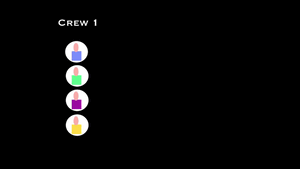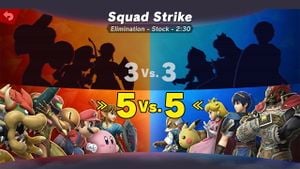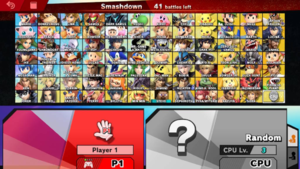Side events
Side events are events played at a tournament setting adjacent to a primary singles and/or doubles tournament. These event typically have lower stakes and are usually done for fun, as well as to play under conditions that couldn't be done as its own standalone event, and to attract players who wouldn't attend for just the primary singles/doubles tournament. Due to the less serious nature, side events usually have a lower entry fee to enter and are often completely free.
Popular formats[edit]
Crew battles[edit]
Occasionally crew battles are run as an official side event, where they can either be two large crews competing, or an entire tournament of many crews. Crews are usually composed of members of preexisting crews, players from the same region, and recruited by a draft, where a team captain drafts other players for their crew. In the past, crew battle tournaments had entry fees and paid out the top placing crews. However, this practice largely ended around 2007.
Friendlies[edit]
A friendly is a match that takes place before or during a tournament but outside of any bracket, being for practice or just for fun in general. Friendlies normally have nothing but pride on the line, but players may compete in a money match instead, where an agreed upon amount of money is paid to the winner. Most money matches range between having 1 to 10 dollars on the line, but some have had players bet as high as 50, 100, or even 1,000 dollars. It's also not unheard of for players to put something non-monetary on the line, such as the loser doing push-ups or entering a tournament with a tag of the winner's choosing. Larger tournaments usually have dedicated areas hosting set-ups for friendlies.
Exhibition/Salty Suite[edit]
An exhibition is a featured match or set between players separate from any tournament. The results of an exhibition match usually don't factor in to any other competitive event and are often treated as its own category in competitive records. Players in an exhibition match are typically famous competitors of high skill level who use the match as an opportunity to show off their skills. Exhibitions are also typically played to settle a feud between the players, with the loser often having to sacrifice something of value to the winner.
An event focused on exhibition matches is colloquially referred as a Salty Suite. Notable streaming groups, such as VGBootCamp, have hosted these types of side events at tournaments such as Apex 2014 and Apex 2015. The salty suite between Leffen and Chillin during the latter tournament, would go on to be the most well known salty suite exhibition set within the greater Smash Bros. competitive scene. Some of these events will also often have additional wager on the line, such as money, or non-monetary wagers such as forbidding the loser from using a particular palette swap at future tournaments.
Combo contest[edit]
A combo contest is an event where players showcase a combo in front of a crowd. The rules are typically that any character can be used on any stage, and as many items as necessary can be used. The combo is judged by a panel that typically rates the combo out of ten. The entrant who performed the combo with the highest overall score wins. While any game in the series is capable of a combo contest, Super Smash Bros. has the most popular combo contest scene by a wide margin due to the game engine allowing for incredibly long combos.
amiibo tournaments[edit]
Some Smash 4 and Ultimate tournaments have side events centered around amiibo. Players can enter their trained amiibo into brackets against other amiibo, with no human players actually taking part in the matches. Some tournaments allow amiibos to be fed equipment or spirits to alter the properties of their attacks or otherwise gain passive bonuses, though there are usually specific rules that dictate what kind and combination of equipment an amiibo can be fed to avoid overpowered entrants. A few tournaments have involved players fighting alongside their amiibo in a doubles format, though these have been very rare.
Squad Strike[edit]
Frequently Ultimate tourneys feature a Squad Strike bracket, sometimes even in the place of a Doubles bracket. These brackets are typically played in Tag Team mode, with players having three characters, and other rules mirroring what the tourney's normal Singles bracket uses. Often tournaments will have a rule that bans Echo Fighters from being used on the same team with their counterparts due to being too similar functionally to their parent character, though which Echoes fall under this ban varies from tourney to tourney; some tournaments may apply the ban to all Echoes, but will frequently exempt Ken, Chrom, and sometimes Lucina due to the more significant differences they have from their respective parent characters.
While crew battles can be run through Elimination mode, crew battles in Ultimate are typically ran outside the mode through the use of standard community-made competitive rulesets, since the built-in Elimination mode has limitations that are deemed unnecessary, such as only allowing one stock per character and not allowing multiples of the same character per team.
Game mod tournaments[edit]
A common side event is a tournament played with one of the various game mods, primarily done to see how the mod plays under tournament conditions. Project+ and its predecessor Project M remain by and far away the most common game mods to be played at tournaments, to the point of developing its own tournament scene; Brawl- and Brawl+, however, also saw appearances at side events. Smash Remix, a 64 mod, has also developed a significant tournament following. For Ultimate HewDraw Remix has developed a significant tournament following.
Modding Melee is significantly less convenient for the end-user because the Smash Stack exploit isn't available, thus fewer Melee mods have been developed. However, SD Remix is a balance mod that is somewhat popular and has side tournaments run for it.
Ultimate has also seen a steady increase of mod usage in tournaments, primarily through file replacement on the Yuzu emulator. The Primary gameplay altering mod is HewDraw Remix that changes the mechanics to be more similar to Melee. Cosmetic mods, including new costumes, textures, and voice clips are also popular to use. A particularly popular type of mod is replacing the floor and wall textures of a stage with the logo of the tournament and/or a featured team.
Other formats[edit]
Free for all[edit]
For a more casual-focused side event, sometimes tourneys may run a bracket that runs FFA matches instead of the standard singles and doubles. Exact rules beyond matches having four players vary, though typically a larger stage selection and items will be allowed too.
All Brawl[edit]
All Brawl is a FFA ruleset that was a semi-popular side event back in the Brawl era, where players competed in 4-player FFA, with items on and every stage legal. The ruleset used for Apex 2012's All Brawl event was:
- Bracket used single elimination.
- 4 players per set.
- Stage choice set to random, every stage could appear
- Players had to pick random character for each match
- All items were set to have a medium probability of appearing
- First player to win 2 games advanced to the next round. 2nd person to advance was decided afterwards in the order of: games won, stock left in the last game, most KOs in the last game.
Amateur bracket[edit]
Players that fail to advance in pools, or who performed poorly in bracket (typically players who went 1-2 or 0-2, but sometimes even those that went 2-2), can be placed into an amateur bracket, to play additional matches without additional cost. Aside from getting to play extra matches, an amateur bracket gives lower level players the opportunity to compete in a tournament with players closer to their skill level that they can more realistically win. Amateur brackets are typically just ran as another double elimination bracket, but sometimes a round robin or ladder format may be used instead. Although it isn't always the case, there will frequently be some sort of prize for the winner of an amateur bracket, which will typically be some sort of merchandise, free entry to an upcoming tournament, a refund of the main tournament's entry free, or a simple small cash prize. Cash prizes are uncommon however, to discourage higher level players from intentionally losing early in the main tournament bracket in order to more easily profit from the amateur bracket.
Low and mid tier tournaments[edit]
A low tier tournament is a tournament that runs under standard rules, with the stipulation being players can only play low and bottom tier characters. What characters are considered "low tier" is at TO discretion. The main purpose of a low tier tournament is to play as characters under tournament conditions that would otherwise be rare in standard tournaments, as comparatively few players use such characters in tournaments, and even fewer players, such as NEO in Melee and Mekos in Brawl, have been able to place well at major tournaments with low tier characters. "Sopo", or a single lead Ice Climber, is sometimes eligible for low-tier tournaments, as well as "Nolimar", Olimar without using any of his Pikmin.
A mid tier tournament is similar to a low tier tournament, except characters in the middle tiers can be played, with those in the top and high tiers being banned. What characters are considered "mid tier" is at TO discretion. The main purpose of mid tier tournaments is to have greater character variety than what a low tier tournament would allow, without having to see the abundance of top and high tier characters that dominate standard tournaments.
Low and mid tier tournaments were at their most popular in Brawl, as they frequently appeared as side events at large tournaments and were treated with a level of seriousness not seen in other side events, with their results even having some impact on the Brawl Back Room's tier list (for example, San's dominance of low tier tournaments with Ike played a role in Ike's big rise from low tier to mid tier on the BBR's fifth tier list, which then disqualified Ike from being used in future low tier tournaments). Low and mid tier tournaments were never popular staples in the other Smash games however; in Smash 4 and Ultimate, the much smaller viability gaps in those games meant lower tier characters appeared frequently enough in standard tournaments that seeing them played at high level didn't have the novelty that seeing them played in Brawl did (while what constituted "low" and "mid" tier in those games was also more heavily debated, with tier cutoffs never having a remote consensus), whereas in Melee, the more severely limited nature of that game's lower tier characters made them largely unpopular to play even in less serious settings and so its playerbase never had much interest in low/mid tier tournaments.
3v3 and 4v4 teams[edit]
With Smash 4 and Ultimate allowing Team Battles for up to eight people to play at once, events for 3v3 and 4v4 teams, also known as triples and quadruples, are sometimes held. The format would be used at tournaments such as Glitch 3 and HYDRA 2019 but due to logistical issues inherent in the format it would have limited usage. With the use of mods increasing possible match sizes Melee would also have a limited number of 3v3 events, such as at Fight Pitt 10.
Special Smash[edit]
Some side tourneys use the Special Smash mode to create custom games and rulesets. The official tournament ruleset is usually partially or entirely thrown out for these events, as they are not meant to be taken seriously and are more of a fun, low-stakes contest. Sometimes there is a prize pot for these events, but not very often. With Melee the most common Special Mode used for events is Giant Melee.
Smashdown[edit]
Some Ultimate tourneys use the Smashdown mode, where everyone is forced to pick a new character every game until none are left. While picking a character for a game is usually done on the spot, some require players to reserve fighters ahead of time to avoid disputes where multiple players want the same fighter. Due to the way Smashdown works, only a maximum of eight players can be in a single tourney, and they all have to play every game. The player that takes the most KOs during the tourney is declared the winner. The tourney can also end early if the mercy rule is on.
Ladder bracket[edit]
A Ladder is a type of tournament bracket where every player is numerically ranked before the tournament starts. Every player is then allowed to challenge a player ranked above them. If the challenger wins, their places in the ladder are swapped. The player at the top of the ladder by the end of the tournament is declared champion. This tournament format is similar to round robin, but with the potential for meaningless matches taken out. Due to the format technically being able to last forever, an endpoint is clearly stated in the rules, like all matches must be played before a certain time to be counted or every player is allowed a maximum amount of challenges. This format is popular at conventions that last multiple days, as players are given ample time to organize games between each other without necessarily being in a professional environment as long as they record and report their own match history, with the winner being declared at the closing ceremony of the final day.
This format is particularly popular online where a single bracket can last for an entire season and allow a theoretically infinite amount of contenders. Websites like Anther's Ladder specialize in this type of tournament.
Speedrunning[edit]
Some tournaments have a dedicated event where players can show their skills in speedrunning a part of a Smash game. These events either consist of players doing runs individually and submitting their best times or are given a goal and each play the game simultaneously to reach the goal first. Due to the nature of speedrunning, these events take significantly less time than a standard bracket tournament, meaning several of these events can be done in a day to fill down time and show off a side of the competitive Smash community less talked about.
Non-Smash Bros. games[edit]
Some tournaments have either official or side events in other games outside of the Smash series. Usually such tournaments would play fighting games such as Street Fighter or Tekken or Marvel vs. Capcom, or occasionally other platform fighters like Smash Bros. fan games and Rivals of Aether. The reverse situation also exists where Smash tournaments are increasingly becoming fixtures at "traditional" fighting game events including prominent ones like CEO. Some events that are primarily focused on "e-sports" games like League of Legends or Counter-Strike may include Smash tournaments. Such events have included Major League Gaming, Press Start, and DreamHack.


